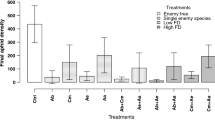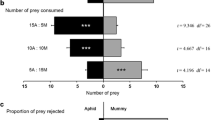Abstract
The question of whether multiple natural enemies often interact to produce lower host mortality than single enemies acting alone has not yet been resolved. We compared the effects of four different combinations of natural enemies-parasitoids, predators, parasitoids plus predators, and no enemies-on caged aphid populations on marsh elder, Iva frutescens, in west-central Florida. Using starting densities of natural enemies commonly found in the field, we showed that parasitoid wasps reduced aphid population densities more than predatory ladybird beetles. The addition of predators to cages containing parasites reduced the ability of parasitoids to decrease aphid population densities. Because the experiments ran only over the course of one generation, such a reduction in the effectiveness of parasites is likely caused by interference of predators with parasitoid behavior. Parasitism in the cages containing both parasitoids and predators was reduced when compared to percent parasitism in parasitoid-only cages, but this could also be due to predation. Our experiments showed that ladybird beetles prey on parasitized aphids. Thus over the long-term, the effectiveness of parasites is impaired by the interference of predators on ovipositing parasitoids and by the predation of parasitized aphids. The effects of natural enemies in this system are clearly non-additive.
Similar content being viewed by others
References
Bertness MD, Wikler K, Chatkupt T (1992) Flood tolerance and the distribution of Iva frutescens across New England salt marshes. Oecologia 91: 171–178
Carroll DP, Hoyt SC (1984) Natural enemies and their effects on apple aphid, Aphis pomi DeGeer (Homoptera: Aphididae), colonies on young apple trees in central Washington. Environ Entomol 13: 469–481
Chambers RJ, Sunderland KD, Wyatt IJ, Vickerman GP (1983) The effects of predator exclusion and caging on cereal aphids in winter wheat. J Appl Ecol 20: 209–224
Chiverton PA (1986) Predator density manipulation and its effects on populations of Rhopalosiphum padi (Hom.: Aphididae) in spring barley. Ann Appl Biol 109: 49–60
Evans EW (1991) Intra versus interspecific interactions of ladybeetles (Coleoptera: Coccinellidae) attacking aphids. Oecologia 87: 401–408
Frazer BD, Gilbert N, Nealis V, Raworth DA (1981) Control of aphid density ty a complex of predators. Can Entomol 113: 1035–1041
Godfray HCJ, Waage JK (1991) Predictive modelling in biological control: the mango mealybug (Rastrococcus invadens) and its parasitoids. J Appl Ecol 28: 434–453
Gutierrez AP, Baumgaertner JU, Summers CG (1984) Multitrophic models of predator prey energetics. III. A case study in an alfalfa ecosystem. Can Entomol 116: 950–963
Gutierrez AP, Neuenschwander P, Schulthess F, Herren HR, Baumgaertner JU, Wermelinger B, Lohr B, Ellis CK (1988) Analysis of biological control of cassava pests in Africa. II. Cassava mealybug Phenacoccus manihoti. J Appl Ecol 25: 921–940
Hacker SD, Bertness MD (1995) The herbivore paradox: why salt marsh aphids live on poor quality plants. Am Nat 145: 192–210
Hagvar EB, Hofsvang T (1988) Interspecific competition between the aphid parasitoids Aphidius colemani Viereck and Ephedrus cerasicola Stáry (Hym., Aphidiidae). J Appl Entomol 106:62–71
Hofsvang T (1990) Advantages and disadvantages of parasitoids and predators of aphids when used in biological control. Acta entomol Bohemoslov 87: 401–413
Jones RE (1987) Ants, parasitoids, and the cabbage butterfly Pieris rapae J Anim Ecol 56: 739–749
Kindlmann P, Ruzicka Z (1992) Possible consequences of a specific interaction between predators and parasites of aphids. Ecol Model 61: 253–265
Mackauer M, Volkl W (1993) Regulation of aphid populations by aphidiid wasps: does parasitoid foraging behavior or hyperparasitism limit impact? Oecologia 94: 939–950
Mills NJ (1982) Voracity, cannibalism and coccinellid predation. Ann Appl Biol 101: 144–148
Prakasan CB, Krishnamoorthy Bhat P (1985) Interference of the predator, Cryptolaemus montrouzieri with the performance of a newly introduced parasite, Leptomastix dactylopii. J Coffee Res 15: 29–32
Rosenheim JA, Wilhoit LR, Armer CA (1994) Influence of intraguild predation among generalist insect predators in the suppression of an herbivore population. Oecologia 96: 439–449
Rosenheim JA, Kaya HK, Ehler LE, Marois JJ, Jaffee BA (1995) Intraguild predation among biological control agents: theory and evidence. Biol Control 5: 303–335
Stiling P (1987) The frequency of density dependence in insect-host-parasitoid systems. Ecology 68: 844–856
Stiling P, Rossi AM (1994) The window of parasitoid vulnerability to hyperparasitism: template for parasitoid complex structure. In: Hawkins BA, Sheehan W (eds) Parasitoid community ecology. Oxford University Press, London
Tscharntke T (1992) Cascade effects among four trophic levels: bird predation on galls affects density-dependent parasitism. Ecology 73: 1689–1698
Author information
Authors and Affiliations
Rights and permissions
About this article
Cite this article
Ferguson, K.I., Stiling, P. Non-additive effects of multiple natural enemies on aphid populations. Oecologia 108, 375–379 (1996). https://doi.org/10.1007/BF00334664
Received:
Accepted:
Issue Date:
DOI: https://doi.org/10.1007/BF00334664




